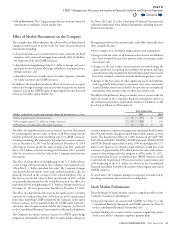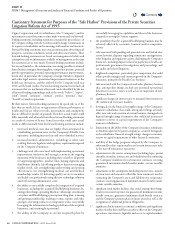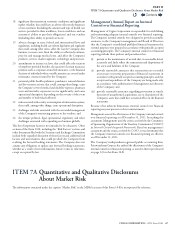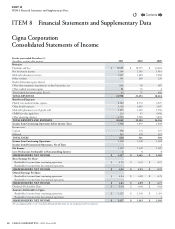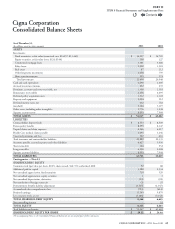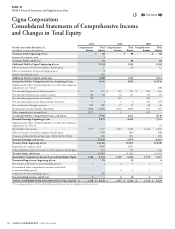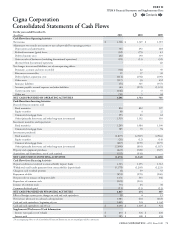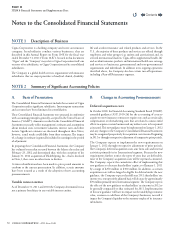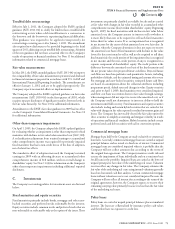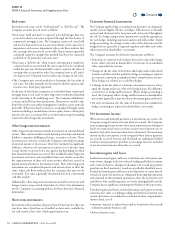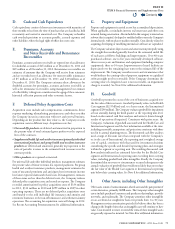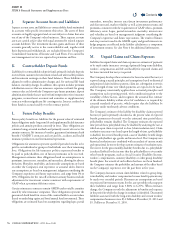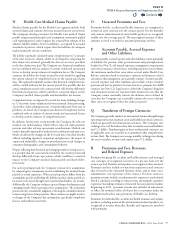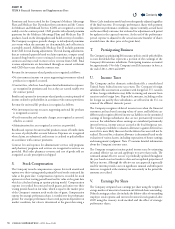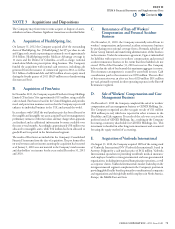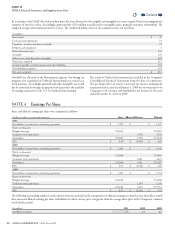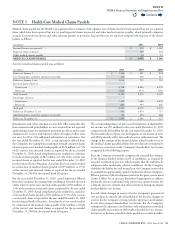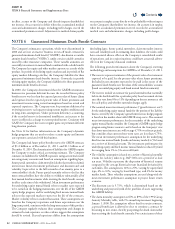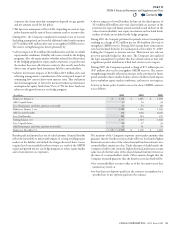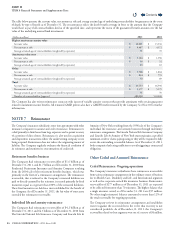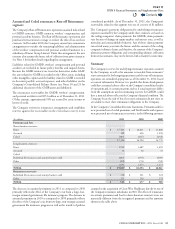Cigna 2011 Annual Report Download - page 97
Download and view the complete annual report
Please find page 97 of the 2011 Cigna annual report below. You can navigate through the pages in the report by either clicking on the pages listed below, or by using the keyword search tool below to find specific information within the annual report.
75CIGNA CORPORATION2011 Form10K
PART II
ITEM 8 Financial Statements and Supplementary Data
D. Cash and Cash Equivalents
Cash equivalents consist of short-term investments with maturities of
three months or less from the time of purchase that are classied as held
to maturity and carried at amortized cost. e Company reclassies
cash overdraft positions to accounts payable, accrued expenses and
other liabilities when the legal right of oset does not exist.
E. Premiums, Accounts
and Notes Receivable and Reinsurance
Recoverables
Premiums, accounts and notes receivable are reported net of an allowance
for doubtful accounts of $45million as of December31,2011 and
$49million as of December31,2010. Reinsurance recoverables are
estimates of amounts that the Company will receive from reinsurers
and are recorded net of an allowance for unrecoverable reinsurance
of $5million as of December31,2011 and $10million as of
December31,2010. e Company estimates these allowances for
doubtful accounts for premiums, accounts and notes receivable, as
well as for reinsurance recoverables, using management’s best estimate
of collectibility, taking into consideration the aging of these amounts,
historical collection patterns and other economic factors.
F. Deferred Policy Acquisition Costs
Acquisition costs include sales compensation, commissions, direct
response marketing, telemarketing, premium taxes and other costs that
the Company incurs in connection with new and renewal business.
Depending on the product line they relate to, the Company records
acquisition costs in dierent ways. Acquisition costs for:
•
Universal life products are deferred and amortized in proportion to
the present value of total estimated gross prots over the expected
lives of the contracts.
•
Supplemental health, life and accidentinsurance (primarilyindividual
internationalproducts) and group healthand accidentinsurance
products are deferred and amortized, generally in proportion to the
ratio of periodic revenue to the estimated total revenues over the
contract periods.
•Other products are expensed as incurred.
For universal life and other individual products, management estimates
the present value of future revenues less expected payments. For group
health and accident insurance products, management estimates the
sum of unearned premiums and anticipated net investment income
less future expected claims and related costs. If management’s estimates
of these sums are less than the deferred costs, the Company reduces
deferred policy acquisition costs and records an expense. e Company
recorded amortization for policy acquisition costs of $334million
in 2011, $312million in 2010 and $299million in 2009 in other
operating expenses. ere are no deferred policy acquisition costs
attributable to the sold individual life insurance and annuity and
retirement businesses or the run-o reinsurance and settlement annuity
operations. e accounting for acquisition costs will change in 2012.
See Recent Accounting Pronouncements for additional information.
G. Property and Equipment
Property and equipment is carried at cost less accumulated depreciation.
When applicable, cost includes interest, real estate taxes and other costs
incurred during construction. Also included in this category is internal-use
software that is acquired, developed or modied solely to meet the Company’s
internal needs, with no plan to market externally. Costs directly related to
acquiring, developing or modifying internal-use software are capitalized.
e Company calculates depreciation and amortization principally using
the straight-line method generally based on the estimated useful life
of each asset as follows: buildings and improvements, 10 to 40years;
purchased software, one to ve years; internally developed software,
three to seven years; and furniture and equipment (including computer
equipment), three to 10years. Improvements to leased facilities are
depreciated over the remaining lease term or the estimated life of the
improvement. e Company considers events and circumstances that
would indicate the carrying value of property, equipment or capitalized
software might not be recoverable. If the Company determines the
carrying value of a long-lived asset is not recoverable, an impairment
charge is recorded. See Note8 for additional information.
H. Goodwill
Goodwill represents the excess of the cost of businesses acquired over
the fair value of their net assets. Goodwill primarily relates to the Health
Care segment ($2.9billion) and, to a lesser extent, the International
segment ($290million). e Company evaluates goodwill for impairment
at least annually during the third quarter at the reporting unit level,
based on discounted cash ow analyses and writes it down through
results of operations if impaired. Consistent with prior years, the
Company’s evaluations of goodwill associated with the Health Care and
International segments used the best information available at the time,
including reasonable assumptions and projections consistent with those
used in its annual planning process. e discounted cash ow analyses
used a range of discount rates that correspond with the Company’s,
or, in the case of International, the reporting unit’s weighted average
cost of capital, consistent with that used for investment decisions
considering the specic and detailed operating plans and strategies
within the segment or reporting unit. e resulting discounted cash
ow analysis indicated an estimated fair value for the Health Care
segmentand International’s reporting unit exceeding their carrying
values, including goodwill and other intangibles. Finally, the Company
determined that no events or circumstances occurred subsequent to the
annual evaluation of goodwill that would more likely than not reduce
the fair value of the Health Care segment or International’s reporting
unit below their carrying values. See Note8 for additional information.
I. Other Assets, including Other Intangibles
Other assets consist of various insurance-related assets and the gain position of
certain derivatives, primarily GMIB assets. e Company’s other intangible
assets include purchased customer and producer relationships, provider
networks, and trademarks. e Company amortizes other intangibles
on an accelerated or straight-line basis over periods from 1 to 30years.
Management revises amortization periods if it believes there has been a
change in the length of time that an intangible asset will continue to have
value. Costs incurred to renew or extend the terms of these intangible assets
are generally expensed as incurred. See Note8 for additional information.
Contents
Q


